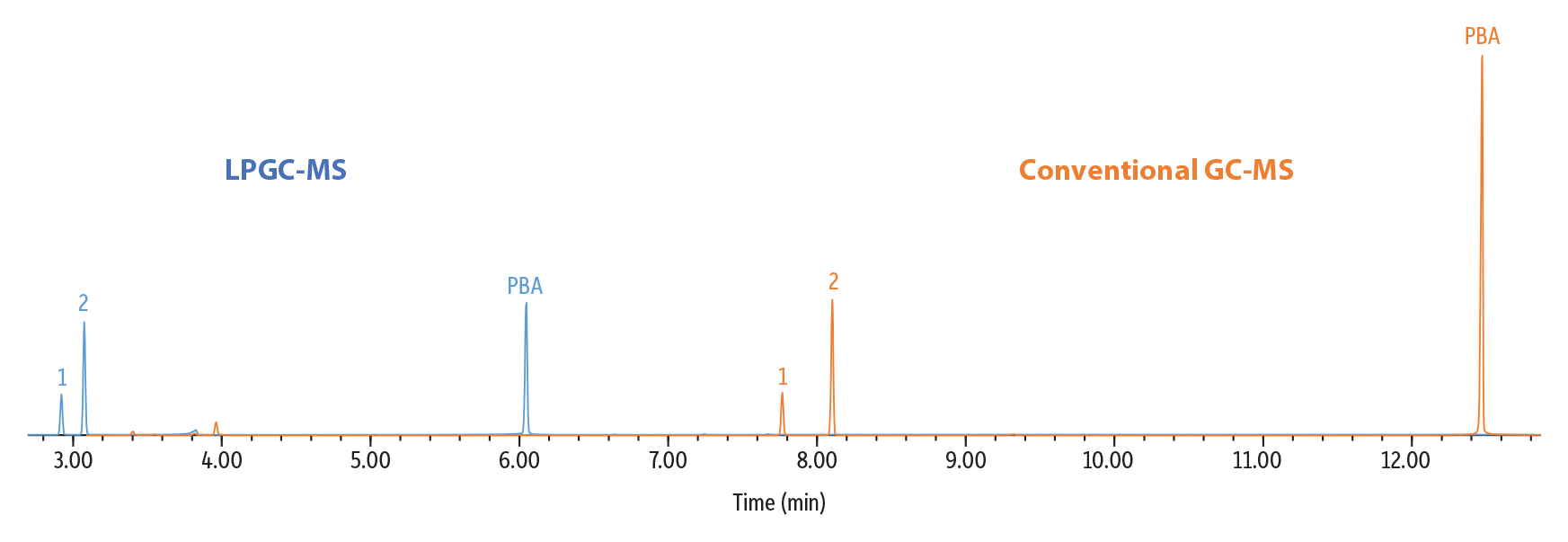Fast Analysis of MCPDs by LPGC-MS
Featured Application: MCPDs on LPGC Rxi-17Sil MS
- 2x faster than conventional GC-MS analysis.
- Reduces helium usage by 69% compared to conventional GC-MS methods.
- Rxi-17Sil MS kits are factory connected with a proven leak-free connector making LPGC as simple as a column change.
MCPDs are impurities found in food products that result from heat processes in manufacturing. They have been largely detected in refined oils, including vegetable oil and palm oil, along with processed foods that use these oils in their formulations, including baby formula. MCPDs are typically analyzed by GC-MS using a 30 m x 0.25 mm ID x 0.25 μm capillary column with a 5% diphenyl, 95% dimethyl polysiloxane or a 50% diphenyl, 50% dimethyl polysiloxane stationary phase. Run times using conventional GC-MS are typically over 12 minutes. With the large volumes of samples laboratories need to process, there is a motivation to cut down on run times, both to increase sample throughput and save on helium costs. However, techniques to shorten analysis times often compromise critical isomer separations.
Low-pressure gas chromatography (LPGC) offers a unique solution: by lowering the pressure inside the GC column, analysis times and helium usage are significantly reduced, allowing laboratories to analyze more samples at a lower production cost. Utilizing our LPGC Rxi-17Sil MS kit (cat.# 11805), analysis time was cut in half, and helium consumption was reduced by 69% compared to conventional GC-MS methods. Additionally, good resolution was achieved for the critical separation of 2-MCPD and 3-MCPD, and these analytes were both resolved well before the derivatization agent. LPGC is as easy as a column change and offers a significant benefit by reducing analysis time, allowing for increased sample throughput while also conserving helium. Each factory-coupled LPGC kit is individually tested to ensure a leak-free connection. To learn more about the LPGC technique, visit www.restek.com/lpgc
Figure 1: MCPDs on LPGC Rxi-17Sil MS Compared to Conventional GC-MS.

| Column | See notes |
|---|---|
| Standard/Sample | 3-MCPD |
| 2-MCPD | |
| Diluent: | Isooctane |
| Conc.: | 30-50 ppm (See the peak table.) |
| Injection | |
| Inj. Vol.: | 1 µL split (split ratio 10:1) |
| Liner: | Topaz 4.0 mm ID single taper inlet liner w/ wool (cat.# 23303) |
| Inj. Temp.: | 280 °C |
| Carrier Gas | He |
| Detector | MS |
|---|---|
| Mode: | Scan |
| Transfer Line Temp.: | 280 °C |
| Analyzer Type: | Quadrupole |
| Source Temp.: | 330 °C |
| Quad Temp.: | 180 °C |
| Electron Energy: | 70 eV |
| Tune Type: | PFTBA |
| Ionization Mode: | EI |
| Instrument | Agilent 7890B GC & 5977A MSD |
| Sample Preparation | Standards were derivatized with 20 µL phenylboronic acid (PBA), saturated solution in diethyl ether, dried, and then reconstituted in 1 mL isooctane in a 2 mL, short-cap, screw-thread vial (cat.# 21143) and capped with a short-cap, screw-vial closure (cat.# 24495). Final concentrations are given in the peak table. |
| Notes | Conventional (30 m) Analysis: Column: Rxi-17Sil MS, 30 m, 0.25 mm ID, 0.25 µm (cat.# 14123) Temp. program: 100 °C (hold 0.5 min) to 180 °C at 12 °C/min to 320 °C at 25 °C/min (hold 4 min) Flow: 1.4 mL/min Scan start time: 3 min Scan range: 50-350 amu Scan rate: 8.5 scans/sec LPGC-MS Analysis: Column: LPGC Rxi-17Sil MS column kit, includes 10 m x 0.32 mm ID x 0.25 μm Rxi-17Sil MS analytical column and 5 m x 0.15 mm ID Rxi restrictor factory connected via SilTite connector (cat.# 11805) Temp. program: 100 °C (hold 0.5 min) to 320 °C at 30 °C/min (hold 5 min) Flow: 0.9 mL/min Scan start time: 1.5 min Scan range: 50-350 amu Scan rate: 8.5 scans/sec |

